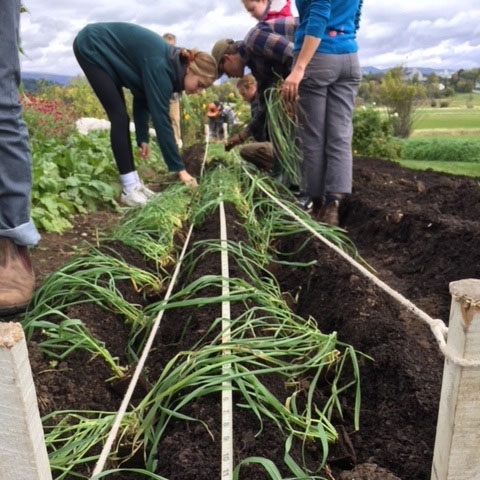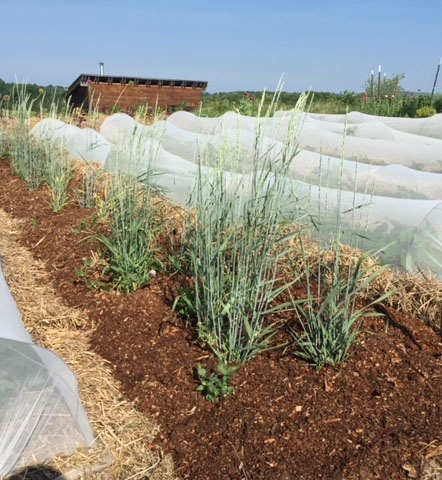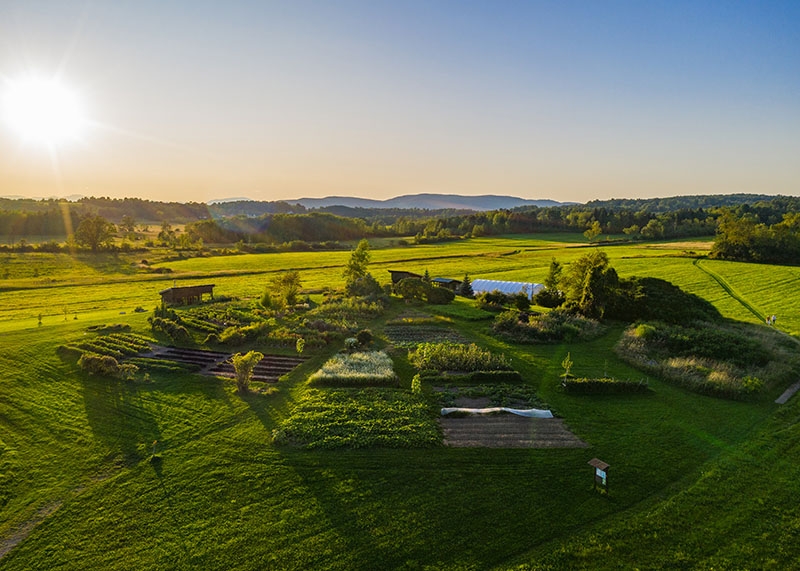Middlebury Explores Agroforestry to Diversify College Farmland

MIDDLEBURY, Vt. - A group of Middlebury College students and a faculty member have begun researching how to transform two large tracts of College-owned farmland into agroforestry landscapes that include trees, shrubs, crops, and possibly livestock. The yearlong initiative is part of the New Perennials Project, led by Scholar in Residence Bill Vitek and previously announced in 2019.
Marc Lapin, College lands conservation and management specialist at Middlebury College, is leading the project. Three students are participating this semester: Clark Devoto ‘23 is working on the project as an independent study, and Willow Galusha ‘22 and Ella Roelofs ‘23 are serving as interns. The group is working with consultant Meghan Giroux, director of Interlace Commons, to develop plans that follow the ancient indigenous land-use practices used in agroforestry.
Agroforestry’s diversification differs from monoculture, or the agricultural practice of growing a single crop or livestock, as is common on U.S. farms today.
“Many of the negative impacts of monoculture are addressed by agroforestry,” said Lapin, who is also an associate laboratory professor of environmental studies. “Agroforestry can help prevent land degradation, restore ecosystem function, and improve rural livelihoods.”
Agricultural landscapes characterized by monoculture and focused on production often function at the expense of human and environmental health, noted Giroux.
“We hope that one of the outcomes of our work is to provide farmers in the Champlain Valley and elsewhere in Vermont with prototypes for diversification,” said Lapin.

A row of young, established Kernza, a perennial grain, grows between rows of annual crops at the Knoll, the College’s education garden. The College is considering including Kernza in its agroforestry plans.
Agroforestry is applied to productive niches of some farms but rarely to whole farms or forests. In the United States, the central agroforestry practices include alley cropping—the practice of combining trees with arable or horticultural crops―and silvopasture—the intentional integration of trees with livestock. In the Northeast, farmers who work with Giroux most commonly request these two practices as the ones that they want to incorporate into their farms.
An agroforestry landscape might typically feature woody plants, trees, and shrubs—all perennials that do not require annual plowing and planting. Agroforestry can include fruit and nut trees, berry bushes, medicinal plants, and crops more typically found on farms, including grass, clover, and corn. Different plants that are mutually beneficial or “allies” are planted alongside each other.
Agroforestry also increases biodiversity and sequesters carbon, said Giroux.
Lapin noted that the land can be somewhat, or very different, looking than a conventional farm. “You might see animals grazing under trees,” he said. “The agroforestry landscape is more visually and ecologically like a mosaic.”
College-Owned Farmland
Lapin, Giroux, and the three students will develop agroforestry designs or a field plan for each of the two tracts of College-owned farmland and then present them to the College Lands Advisory Committee. The fields are located in the following areas:
-
25-acres: The land is west of the College’s education garden, the Knoll, and off of Route 125. It was once used to grow willow as test fuel for Middlebury’s biomass plant and prior to that was cow pasture. Its proximity to campus is ideal for educational purposes.
-
35-acres: The land is north of Middlebury on Route 7 and was formerly part of the Quesnel Farm. The College leases the fields to a local farmer.
Developing the Plans for Agroforestry
To help develop the plan, the students will create a site assessment that documents the components of the land’s ecosystems, including plants, animals, air, minerals, temperature, and sunlight. Their analysis will also record social and economic conditions that influence successful site development—how agroforestry can simultaneously increase ecological functions such as water quality and pollination as well as farm profitability.
To complete their research, the students will interview experts in agroforestry and carbon farming, which applies practices designed to reduce emissions from farming activities and sequester carbon in soil, vegetation, and other natural sources. Lapin plans to continue working with students in the fall.
Lapin said that one crop under consideration for a portion of the Middlebury farmland is a type of perennial sunflower, Silphium, grown for its seed oil. The crop, along with Kernza, which is a registered trademark, and several other perennial grains, is in development at the Land Institute in Kansas.
“I am excited about working with Middlebury since colleges and universities are key to breaking down the barriers to adopting agroforestry,” said Giroux, who regularly collaborates with

The College is developing agroforestry designs or a field plan for College-owned farmland pictured above, west of the College’s education garden, the Knoll, off of Route 125.
farms, institutions, and nonprofits. “It’s an opportunity to transfer knowledge to younger generations interested in ways of combining conservation with production.”
Lapin knows that there are farmers who may be skeptical about agroforestry but also observes that many are interested in diversifying and that agroforestry is not new. He noted that Middlebury’s project has gained favorable attention from the Vermont Agency of Agriculture, Food, and Markets.
“I’m very pleased that College land is increasingly serving as an educational resource,” said Lapin, who has been building the lands educational program at the College since 2009. He cited examples of similar past student involvement, including ecological and stewardship work on the conserved forestland surrounding Middlebury’s Bread Loaf campus in Ripton and the organization of a College property GIS database for the Office of Business Services. Lapin believes that Middlebury’s 6,000 acres of land in Addison County offer numerous opportunities to students who are interested in conservation, restoration, and regenerative land uses.
The New Perennials Project
Along with the development of agroforestry, the New Perennials Project calls for the application of perennial principles to other initiatives, including an effort to grow perennial wheat, sunflowers, and other demonstration crops at the Knoll; an open-access publishing platform; new courses, including The Perennial Turn and Walking Body, Walking Mind; and collaborations with a network of community partners such as the Willowell Foundation, Gedakina, and Bread and Butter Farm as well as All Souls Interfaith Gathering and Courageous Stage.
Interlace Commons’ mission is to promote the adoption of agroforestry land use practices that address climate change and land degradation and move toward resilient, biodiverse landscapes that enhance rural livelihoods. We achieve our mission through farmer-driven field projects, education, and research initiatives throughout the Northeastern United States. More information is available on Facebook, Instagram, and Twitter.

